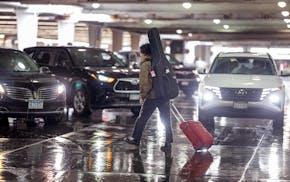It's the theme of many a torch song or country western ballad: Booze dulls the hurt.
But while songs like "One for My Baby (And One More for the Road)" and "There's a Tear in My Beer" are about easing the ache of lost love, a new study by University of Minnesota researchers shows that alcohol also can reduce the perception of physical pain.
They know that because they recruited test subjects in various states of inebriation who were attending the recent Minnesota State Fair.
They gave the adult volunteers breathalyzer tests, and then they poked the volunteers' hands with a test device and said, "Tell me when it hurts."
The results: The more intoxicated you are, the higher your pain threshold.
The experiment was conducted by scientist Jeff Boissoneault, director of the Minnesota Alcohol and Pain Lab, a new research center that looks at the ways that pain and alcohol use are interconnected.
Boissoneault said previous research has shown that a substantial proportion of pain sufferers — 25 to 40% — report using alcohol to manage their pain at least some of the time.
Other laboratory experiments have shown that intoxication actually does reduce pain perception.
But the new U study shows the pain-easing effect of booze works outside of the lab, at different levels of intoxication, among both men and women, and "resulting from naturalistic alcohol use at a public event."
Boissoneault's research team recruited the test subjects among people who dropped by the University of Minnesota's Driven to Discover building on the fairgrounds over five afternoons and evenings during the fair's run.
They were able to sign up 149 volunteers. About 55% were women. About 31% of the volunteers showed some alcohol use, with an average blood alcohol level of 0.038. The most inebriated test subject had a blood alcohol level of 0.12.
The researchers excluded potential volunteers with blood alcohol levels above 0.15 out of concerns they might be too drunk to give proper informed consent to be studied.
The researchers measured pain thresholds using a $5,000 handheld device called a pressure algometer. It's basically a fancy pressure sensor that measures how much force you're exerting if you press a knob into someone's knee or shoulder.
The researchers poked test subjects in the fleshy part of the hand between the base of the thumb and the index finger, also known as the first dorsal interosseus muscle.
Then they recorded how much force the test subject was enduring at the moment that they told the experimenter that the sensation changed from pressure to pain. (Test subjects weren't paid, but they did get a U-branded cup.)
The results indicate that the pain-reducing effects of booze seem to increase in a linear fashion, according to Boissoneault. In other words the more you drink, the less it hurts.
In short, the expression "He's feeling no pain" to describe a drunk person has some scientific basis.
The research also suggests that screenwriters of old western and war movies got it right when they depicted a character taking slugs out of a bottle of whiskey before undergoing an operation without proper anesthesia.
"It's something that's so ingrained in the culture," Boissoneault said of the idea that alcohol eases pain.
The risky side
But using alcohol for pain management is risky.
"This is concerning given evidence that chronic heavy alcohol consumption increases risk of developing chronic pain, as well as alcohol-related problems," according to a summary of the experiment.
Boissoneault said the result from the study "does imply that the more you're drinking, the greater the effect of it on pain. But there's also more risk associated with those levels of drinking."
Researchers have found that people who seek treatment for alcohol problems are more likely to have chronic pain than the general population and that the pain was a contributor to their desire to drink.
In the short term, a person may numb the pain by drinking, but in the long term they may be making their problem worse.
Boissoneault said heavy alcohol users are at risk of getting into a vicious cycle, triggering a condition associated with heavy alcohol use called neuropathic pain. They also may experience pain when withdrawing from alcohol.
These links between pain and alcohol use imply that in the long term, heavy alcohol users could reduce their pain by actually using less alcohol, and caregivers may be able to intervene to reduce alcohol use by finding treatments to relieve pain in heavy drinkers.
Boissoneault did other studies in his previous job at the University of Florida, where he and colleagues worked with 3-D game developers to create a virtual reality bar for drinking experiments.
Test subjects would wear VR headsets that made it appear they were sitting in a bar. They took sips of real booze — Yuengling Traditional Lager or Angry Orchard Hard Cider — and set their bottles down on a Bluetooth-connected scale that measured their sip frequency and volume.
Researchers also strapped a thermosensory stimulator to the bare calf of the test subjects.
A thermosensory stimulator is a $30,000 machine with a 3- by 3-centimeter pad that can create temperatures on your skin that range from freezing to "Ouch, that's hot!"
The researchers found that when test subjects had the painfully hot (111 degrees F.) pad attached to their leg, men but not women drank their beer faster.
The findings align with other research that shows men are more likely than women to endorse self-management of pain by using alcohol.
Boissoneault said experiments with rodents given access to alcohol also have shown that male rodents were more likely than female rodents to drink from a water bottle with an alcohol solution when subjected to pain.
Toasting the virtual bar
Boissoneault said the virtual bar he and fellow researchers created for drinking research is less expensive, more standardized and perhaps creates a more realistic drinking environment than other drinking experiment settings, which typically involve building a fake bar in a laboratory space or in a room in the basement of a hospital.
The virtual bar, which is being made available to other researchers, is a bright, well-lit room that includes a dartboard, a sign with happy hour specials and picture windows looking out over a mountain vista.
"This is the first one we put together. We call it the Swiss mountain pub," Boissoneault said.
Experimenters can further simulate the bar environment with "a playlist of popular music from the 1970s to 2010s played over the headset."
There can even be other patrons. In one experiment that Boissoneault worked on, test subjects could see a digital person drinking at the other end of the bar.
In sessions where the experimenters simply cued the virtual barfly to drink faster, the test subjects drank faster, too.
Boissoneault said he was surprised that seeing a digital character in the background drinking faster could affect real drinking behavior.
"If we had that kind of effect with just this simple virtual person who's not even engaging with you, that suggests to me that the real social influence on people's drinking is probably a lot stronger," Boissoneault said.
He said future research by the Minnesota Alcohol and Pain Lab will involve more use of the virtual bar as well as putting subjects in a high-strength MRI to get images of what's happening in the brain when people are using alcohol and experiencing pain.

You can sign up to earn Delta SkyMiles with Uber starting today

Justin Hayward explains the noisy cat on 'Nights in White Satin' and other Moody Blues stories

These 5 Twin Cities area fashion shows celebrate spring

